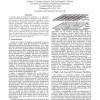Free Online Productivity Tools
i2Speak
i2Symbol
i2OCR
iTex2Img
iWeb2Print
iWeb2Shot
i2Type
iPdf2Split
iPdf2Merge
i2Bopomofo
i2Arabic
i2Style
i2Image
i2PDF
iLatex2Rtf
Sci2ools
DATE
2003
IEEE
2003
IEEE
Layered, Multi-Threaded, High-Level Performance Design
A primary goal of high-level modeling is to efficiently explore a broad design space, converging on an optimal or near-optimal system architecture before moving to a more detailed design. This paper evaluates a high-level, layered software-on-hardware performance modeling environment called MESH that captures coarse-grained, interacting system elements. The validity of the high-level model is established by comparing the outcome of the high-level model with a corresponding low-level, cycle-accurate instruction set simulator. We model a network processor and show that both high and low level models converge on the same architecture when design modifications are classified as good or bad performance impacts.
Broad Design Space | DATE 2003 | Environment Called Mesh | Hardware | Layered Software-on-hardware Performance |
| Added | 04 Jul 2010 |
| Updated | 04 Jul 2010 |
| Type | Conference |
| Year | 2003 |
| Where | DATE |
| Authors | Andrew S. Cassidy, JoAnn M. Paul, Donald E. Thomas |
Comments (0)

